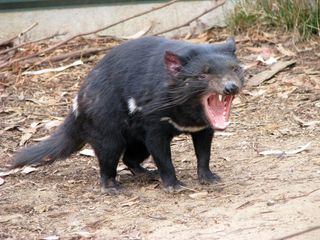Facts About Tasmanian Devils

Tasmanian devils are small marsupials with ratlike features, sharp teeth and coarse black or brown fur. Diminutive as it may be, don't be fooled: This creature has a fighting style that is quite intimidating.
Size
The real Tasmanian devil doesn't really resemble the famous cartoon character. It isn't the same size as humans, for example. Nor does it storm through its surroundings like a swirling tornado. The Tasmanian devil is just 20 to 31 inches (51 to 79 centimeters) tall and weighs only 9 to 26 lbs. (4 to 12 kilograms).
Habitat
The Tasmanian devil is found on the island of Tasmania in Australia — an area of about 35,042 square miles (90,758 square kilometers). Though Tasmanian devils can live anywhere on the island, they prefer coastal scrublands and forests, according to National Geographic. But no matter what area of the island they inhabit, these animals sleep under rocks or in caves, logs or burrows.
Habits
The cartoon Tasmanian devil does have one thing in common with the real creature: poor temperament. When the devil feels threatened, it goes into a rage in which it growls, lunges and bares its teeth. It also makes otherworldly screams that can seem very devil-like. It may be due to this temper that the Tasmanian devil is a solitary creature.
The Tasmanian devil is also nocturnal; it sleeps during the day and is awake at night. During the night, they sometimes journey up to 10 miles (16 km) to hunt, according to the San Diego Zoo.
Diet
The Tasmanian devil is the world's largest carnivorous marsupial, according to National Geographic. Most of the time, they eat birds, snakes, fish and insects. Often, they feast on dead carcasses, called carrion. Sometimes, many devils converge on one carcass, and fighting ensues.
When they have a meal, Tasmanian devils don't waste any part of the animal; they eat the bones, hair, organs and muscle of their prey.
Offspring
Tasmanian devils typically mate once a year in March. Mother devils have a gestation period of around three weeks, and the babies are born in April. She will have up to 50 young at once. The young, called imps, are pink and hairless and only about the size of a grain of rice, according to the San Diego Zoo.
At birth, the imps must race to the mother's pouch, where they compete for one of her four teats. Only those four will have a chance of surviving; the others will die due to malnourishment.
Babies stay in their pouch for four months. Once they come out, they are weaned, and the mother will carry the imps on her back. By eight to nine months, the imps are fully grown. Tasmanian devils live five to eight years.
Classification/Taxonomy
Here is the taxonomy of Tasmanian devils, according to the Integrated Taxonomic Information System (ITIS):
- Kingdom: Animalia
- Subkingdom: Bilateria
- Infrakingdom: Deuterostomia
- Phylum: Chordata
- Subphylum: Vertebrata
- Infraphylum: Gnathostomata
- Superclass: Tetrapoda
- Class: Mammalia
- Subclass: Theria
- Infraclass: Metatheria
- Order: Dasyuromorphia
- Family: Dasyuridae
- Subfamily: Dasyurinae
- Tribe: Dasyurini
- Genus: Sarcophilus
- Species: Sarcophilus
- Subspecies: Sarcophilus harrisii dixonae, Sarcophilus harrisii harrisii
Conservation status
According to the International Union for Conservation of Nature's Red List of Threatened Species, Tasmanian devils are endangered, and their population numbers are declining. In 2007, the IUCN estimated that the population may have been around 25,000 adults.
The Tasmanian devil's population has declined by at least 60 percent since 2001 due to a cancer called devil facial tumor disease (DFTD). DFTD causes tumors to form on the devil's facial area, making it difficult for them to eat. Eventually, the animal starves to death. The Save the Tasmanian Devil Program is an initiative created by the Australian and Tasmanian governments to save the animals from DFTD.
Other facts
The Tasmanian devil's front legs are longer than its back legs.
Even though it is small, it has one of the most powerful bites in the animal world, due to its muscular jaw, according to National Geographic.
Tasmanian devils store extra fat in their tails.
Though awkward on the ground, Tasmanian devils are good tree climbers.
Additional resources
Sign up for the Live Science daily newsletter now
Get the world’s most fascinating discoveries delivered straight to your inbox.
